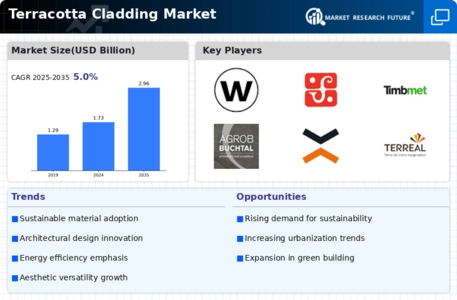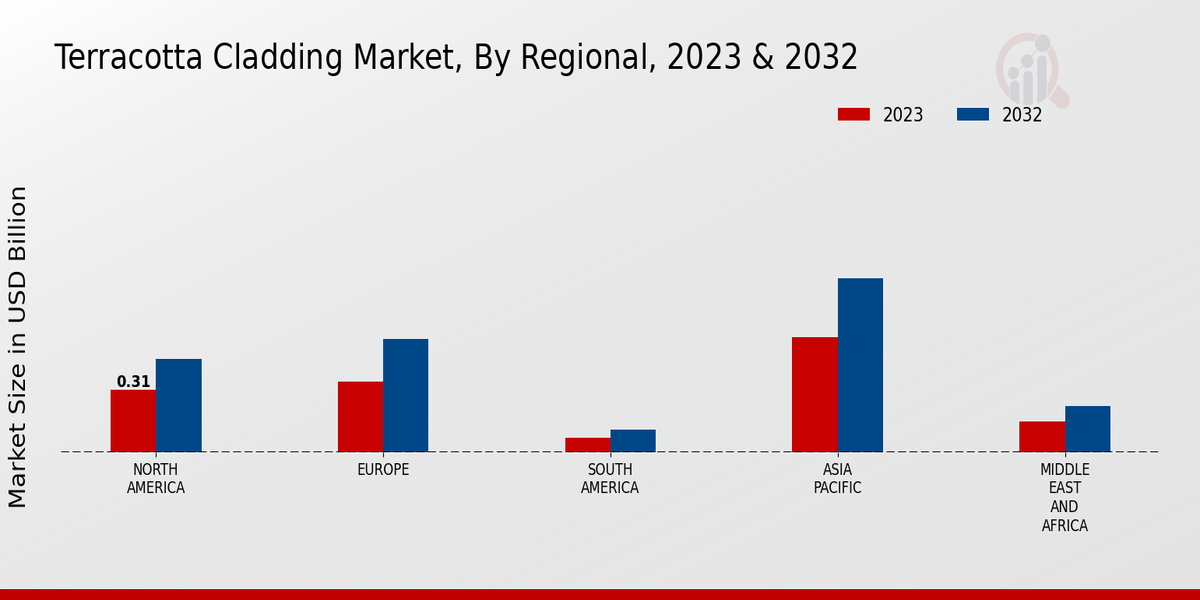Aesthetic Versatility
The aesthetic versatility of terracotta cladding significantly contributes to its popularity within the Global Terracotta Cladding Market Industry. This material offers a wide range of colors, textures, and finishes, allowing architects to create visually appealing facades that cater to diverse architectural styles. From modern to traditional designs, terracotta can be adapted to meet various aesthetic requirements. This adaptability not only enhances the visual appeal of buildings but also increases their market value. As urbanization continues to rise globally, the demand for aesthetically pleasing yet durable materials like terracotta is expected to grow, further driving market expansion.
Market Growth Projections
The Global Terracotta Cladding Market Industry is projected to experience substantial growth in the coming years. With a market value expected to reach 1.73 USD Billion in 2024 and further increase to 2.96 USD Billion by 2035, the industry is on a promising trajectory. The anticipated CAGR of 5.01% from 2025 to 2035 suggests a robust demand for terracotta cladding driven by various factors, including sustainability, aesthetic appeal, and regulatory support. This growth reflects a broader trend towards environmentally friendly construction materials, positioning terracotta cladding as a key player in the evolving landscape of the construction industry.
Durability and Low Maintenance
Durability and low maintenance requirements are key factors driving the Global Terracotta Cladding Market Industry. Terracotta cladding is renowned for its resistance to weathering, fading, and damage, making it an ideal choice for various climates. This longevity reduces the need for frequent replacements or repairs, which can be costly and time-consuming. As property owners and developers seek to minimize long-term maintenance costs, the appeal of terracotta cladding becomes increasingly evident. The market is anticipated to grow at a CAGR of 5.01% from 2025 to 2035, reflecting the increasing recognition of terracotta's durability in construction.
Sustainable Building Practices
The Global Terracotta Cladding Market Industry is experiencing a notable shift towards sustainable building practices. As environmental concerns gain prominence, architects and builders increasingly favor materials that are eco-friendly and energy-efficient. Terracotta cladding, known for its natural composition and recyclability, aligns well with these practices. This trend is reflected in the growing demand for terracotta products, which are often sourced from local materials, reducing transportation emissions. The market is projected to reach 1.73 USD Billion in 2024, indicating a robust interest in sustainable construction solutions that terracotta cladding provides.
Regulatory Support for Green Building
Regulatory support for green building initiatives is a significant driver of the Global Terracotta Cladding Market Industry. Governments worldwide are implementing stringent building codes and standards that promote the use of sustainable materials. Terracotta cladding, with its low environmental impact and energy efficiency, aligns well with these regulations. As a result, builders are incentivized to incorporate terracotta into their projects to comply with green building certifications. This regulatory push not only enhances the market for terracotta cladding but also encourages innovation in sustainable construction practices, fostering a more environmentally conscious industry.
Technological Advancements in Manufacturing
Technological advancements in manufacturing processes are reshaping the Global Terracotta Cladding Market Industry. Innovations in production techniques have led to improved quality, consistency, and customization of terracotta products. Enhanced manufacturing capabilities allow for the creation of lightweight, high-performance cladding solutions that meet modern architectural demands. As the industry embraces these advancements, the market is poised for growth, with projections indicating a rise to 2.96 USD Billion by 2035. This evolution in manufacturing not only boosts the appeal of terracotta cladding but also positions it as a competitive option in the broader construction materials market.









